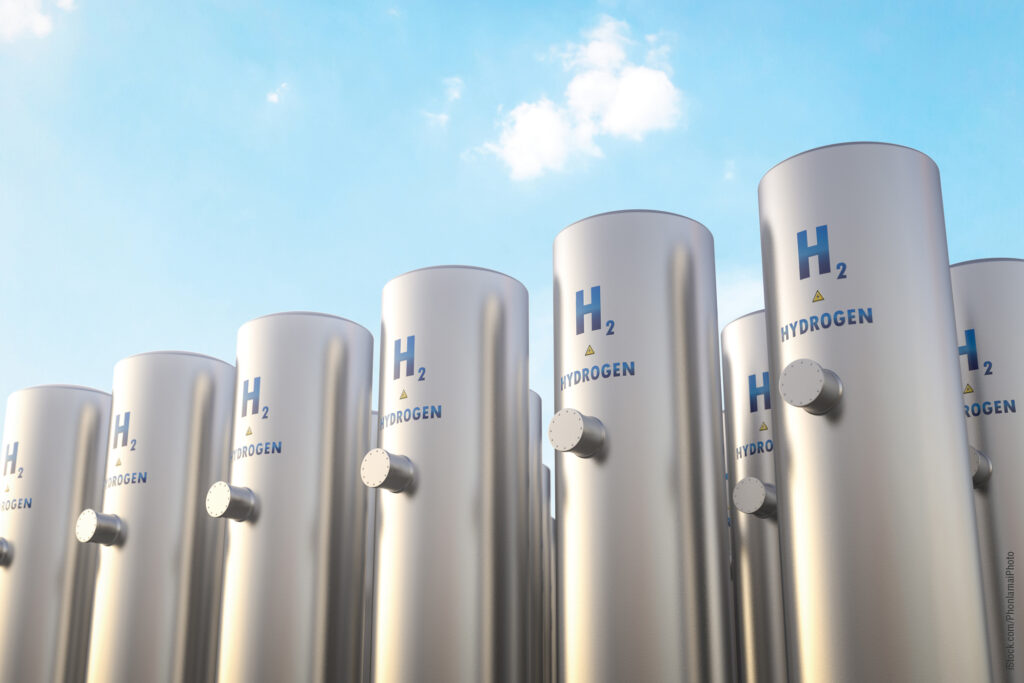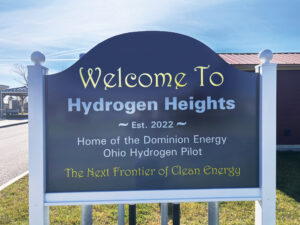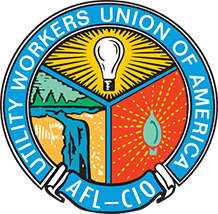
After a year-long competition, the Biden Administration announced seven regional hydrogen hubs that will receive $7 billion in federal investment. These projects will spearhead development of clean hydrogen as an energy source and contribute to the national goal of net zero greenhouse gas emissions by 2050.
The Regional Clean Hydrogen Hubs Program, known as H2Hubs, will build the foundation of a national hydrogen network that will help decarbonize sectors that are difficult to tackle by other means, such as steel and cement production, building stock, shipping, public transportation, and long-distance trucking.
The hub award announcement in October represented a major step on the journey from the concept of a hydrogen economy (see Jul-Aug-Sept 2022 issue of The Utility Worker) to implementation. The federal program is projected to catalyze more than $40 billion in private investment and anticipates commercial production of hydrogen no later than 2035.
In good news for UWUA members, the White House forecasts the H2Hubs will produce “tens of thousands of good-paying jobs.” The Biden Administration has stated that unions will play a key role in ensuring that the emerging hydrogen industry provides quality jobs and has clear pathways for workforce transition, especially for those workers affected by the move away from fossil fuels.
“We’re getting in at the ground floor and making sure there will be a role in whatever comes for our members,” said Eddie Hall, president of UWUA Local G-555 in Ohio.
Hydrogen and the hubs program
Nearly 80 proposals competed for the regional hydrogen hub investment. Congress approved $8 billion for the hubs under Biden’s Bipartisan Infrastructure Law in 2021. As further impetus, the Inflation Reduction Act of 2022 included tax credits for companies producing low-emissions hydrogen. The IRS is still drafting rules for those credits, and economists predict they could be worth billions of dollars.
 The Department of Energy (DOE) says that the hubs will ultimately produce 3 million metric tons of hydrogen annually, and the federal government predicts hydrogen produced by the hubs will ultimately eliminate 25 million metric tons of carbon dioxide emissions, equivalent to about 5.5 million gas-powered cars.
The Department of Energy (DOE) says that the hubs will ultimately produce 3 million metric tons of hydrogen annually, and the federal government predicts hydrogen produced by the hubs will ultimately eliminate 25 million metric tons of carbon dioxide emissions, equivalent to about 5.5 million gas-powered cars.
The hub initiatives will also seek to solve technical hurdles in carbon capture and storage technology, capacity constraints in wind- and solar-powered production of hydrogen, methane leakage and ways to lower hydrogen production costs.
Recall that hydrogen does not exist in its pure form on earth, only occurring in compounds such as water and natural gas. This means energy is required to split the molecules of these compounds and separate hydrogen, such as through the electrolysis of water. When burned in a fuel cell, hydrogen produces only water or water vapor, no carbon dioxide. But the full environmental impact of hydrogen depends on the energy source that powers the splitting of the molecules and isolating hydrogen. The most widely available form of hydrogen today is derived from natural gas using a steam process. Carbon dioxide is released, so this form is considered the least sustainable, unless it is accompanied by some form of carbon capture.
For a hub to qualify for DOE funding, hydrogen to be produced must be classified as “clean”. That means it must come from “clean” energy sources such as wind, solar, hydropower, nuclear, or natural gas accompanied by carbon capture that is at least 95% effective.
Winning hub projects
The winning H2Hubs span 16 states, and the proposals represent cooperative initiatives among many stakeholders, both public and private. The hubs’ names are acronyms that can be confusingly similar, and they cover the following areas:
- HyVelocity H2Hub: Gulf Coast and Texas
- MACH2: Mid-Atlantic (PA, DE, NJ)
- ARCH2: Appalachia (PA, WV, OH)
- MachH2: Midwest (IL, IN, MI)
- HH2H: Upper Midwest (MN, ND, SD)
- PNWH2: Pacific Northwest (WA, OR, MN)
- ARCHES: California
The seven winning hubs will use a variety of energy sources to produce hydrogen, including natural gas, nuclear power, biomass and renewable energy. Those that use fossil fuels will capture and store the emissions released in production.
A major goal is to expand production and reduce the cost of clean hydrogen so it becomes a viable alternative to current fuel sources. As a result, the DOE predicts that demand for cleaner hydrogen could hit 10 million tons per year by 2030 from almost nothing currently.
The hubs represent an array of approaches. California’s ARCHES, for example, intends to make hydrogen with renewable energy and biomass and use hydrogen to power port operations in Los Angeles, public transportation, and heavy-duty transport. The ARCH2 Appalachia hub along with two others plan to continue the use of natural gas but capture the carbon emissions and store them underground.
Observers of the hub program see the regional initiatives as experiments in potential business models for hydrogen and opportunities to solve technology and infrastructure challenges. The next step for the seven hubs will be to draft more detailed plans for submission to the DOE, which will have the final say on what moves forward.
The H2Hubs program entails a strong commitment to labor unions. “Labor folks in particular have a lot riding on the hydrogen economy,” said Betony Jones, director of DOE’s Office of Energy Jobs in a briefing when the winning proposals were announced. “It’s an opportunity to retain high-wage, union jobs as we transition to clean energy. These hubs represent a significant opportunity to build a whole new industry.”
This commitment is apparent in the community benefit plans that are required of all the hubs. These plans must address priorities including investing in the workforce and engaging communities and labor. More than 65 labor organizations signed letters of support for hubs that were selected.
UWUA involvement and impact
UWUA locals play key roles in many of the winning hubs.
The ARCH2 Appalachia hub prioritizes ensuring that the energy transition is fair in a region disproportionately impacted by the loss of extractive industry jobs. It will use natural gas with carbon capture to produce hydrogen. At its peak, ARCH2 will create more than 18,000 construction jobs and offer more than 3,000 permanent jobs.
UWUA Local G-555 and its employer Dominion Energy are founding members of the ARCH2 hub alliance. While Dominion is in the process of selling its Ohio gas operations to Canada-based Enbridge, Local G-555 President Eddie Hall and Vice President Paul Talboo say Enbridge is fully committed to picking up Dominion’s role in the alliance: “Enbridge has a similar net zero plan to Dominion but is further along in its use of both hydrogen and biofuel. It’s been testing and blending hydrogen for over twenty years and brings a lot of experience to the alliance.”
G-555 has about 1,000 members, and Talboo said that while there aren’t a lot of details known at this point, the local’s officers are actively engaged in discussions to ensure that members will have a role: “G-555 has made it known that our members want to be part of whatever lies ahead. It’s our job to fight for and secure this work.”
Two things are known: Dominion added a hydrogen blending system at its main training facility in Boston Heights this past summer, and Stark County, home to Canton, Ohio, operates the country’s second largest fleet of hydrogen-powered vehicles. The county currently imports hydrogen from Canada. Under ARCH2, Dominion/Enbridge will supply the hydrogen and capture and sequester the carbon emissions. “We have asked how G-555 can be a part of these and all other hydrogen projects,” said Talboo.
ARCH2 will also incorporate West Virginia natural gas operations that were recently sold by Dominion to Hope Gas, where UWUA Local 69 represents gas workers. Jason Boyce, the local’s president, has had discussions with the company’s management and says it’s committed to adding hydrogen to its mix. He shared, “Hope is currently in discussions with the Public Service Commission and other government entities to figure out exactly what the future will look like. Regardless of whether it ends up pursuing a pure hydrogen or a hydrogen-natural gas blend strategy, Local 69 members do Hope’s distribution work. So, as Hope adds hydrogen, this will be our members’ work.”
In California, UWUA Local 483 in Los Angeles and SoCal Gas are founding members of the ARCHES hub. ARCHES expects to create 130,000 construction jobs and 90,000 permanent jobs. Local 483 President Ernie Shaw said, “We’re optimistic about what ARCHES will mean for SoCal Gas workers. While there are many unknowns at the moment, we expect we’ll get a clearer picture over the next year and start to see implementation in the following year.”
One of ARCHES’s goals is to transport generated hydrogen via pipeline to the Port of Los Angeles where it will be used to fuel dock vehicles currently powered by compressed natural gas or diesel. There is also discussion on the potential use of hydrogen for fueling ships.
Shaw has full confidence that as the hub develops, Local 483 members will benefit: “We’ll be the ones building and maintaining the transmission lines that will be used for transporting the hydrogen. Our members will be calibrating and maintaining the equipment that accepts the hydrogen or hydrogen blends.”
The National Union has been actively working to ensure that UWUA members are beneficiaries of these hubs. When the DOE initially announced the program, it asked stakeholders for comments on criteria to utilize when awarding hub funding. The UWUA urged DOE to be technology agnostic and focus on areas of the country that have high concentrations of fossil fuel energy workers with the goal of utilizing the existing skill sets of these workers.
Currently, the UWUA is working with the AFL-CIO to ensure that union workers are incorporated into H2Hubs project implementation and have opportunities to expand their skill sets and that all technologies that the DOE initially identified as “clean hydrogen” qualify equally for the tax incentives currently under consideration by the IRS.
Looking forward
The government will roll out funding for the hubs in four phases, starting with detailed planning and culminating in full operation. Hubs will have to demonstrate adequate progress to unlock more funding at each phase. Construction of the hubs is due to start within five years and be fully operational at year eight.
In an analysis of the hub announcement, the Center for Strategic and International Studies said that end uses for hydrogen are currently the least developed element of the hub initiative. End users are hesitant to commit to long-term hydrogen agreements because they anticipate costs will fall. So, the DOE’s efforts to develop the demand side will be important to success.
While many details are yet to be defined, the selection of the winning hubs is an important milestone in the nation’s energy transition, and UWUA members are poised to play critical roles in securing hydrogen’s place in a reduced carbon energy economy.

